Vous êtes ici : Accueil › DECLIC : Séminaire sur l'usage des sols "What have been the robust biogeophysical impacts of land-use induced land-cover changes on climate since 1850 ?"
DECLIC : Séminaire sur l'usage des sols "What have been the robust biogeophysical impacts of land-use induced land-cover changes on climate since 1850 ?"
06 décembre 2010
Paris (France)
Les séminaires "usages des sols et climat" constituent une plate-forme de dialogue et d'échanges en vue de la réalisation du principal objectif du projet DECLIC : construire un modèle intégré économie-climat-cycles. A vocation fortement interdisciplinaire, ils représentent un outil essentiel pour faciliter le couplage des modèles climatiques aux modèles de carbone.
Le prochain séminaire aura lieu le 6 décembre à 16h en salle 13 à l'Agroparistech (16 rue Claude Bernard - M° Censier Daubenton).
Nathalie De Noblet présentera ses travaux intitulés "What have been the robust biogeophysical impacts of land-use induced land-cover changes on climate since 1850 ?"
Abstract
What have been the robust biogeophysical impacts of land-use induced land-cover changes on climate since 1850 ?
Nathalie de Noblet-Ducoudré, Andy Pitman, Juan Pablo Boisier, Faye Cruz and LUCID participants
The project "Land-Use and Climate, IDentification of robust impacts" (LUCID; de Noblet-Ducoudré and Pitman, iLEAPS Newsletter 4, 2007) was conceived under the auspices of IGBP-iLEAPS and GEWEX-GLASS, to address the robustness of local/regional and possible remote impacts of land-use induced land-cover changes (LULCC). LUCID explores, using methodologies that major climate modelling groups recognise, those impacts of LCC that are robust - that is, above the noise generated by model variability and consistent across a suite of climate models.
Seven climate models were run, in ensemble mode (5 realisations per 31-years long experiment), with prescribed observed sea-surface temperatures (SSTs) and sea ice extent. Pre-industrial and present-day simulations were used to explore the impacts of biogeophysical impacts of human-induced land cover change (Pitman et al., GRL2009).
The imposed LCC perturbation led to a number of statistically significant changes, that are common to all models : enhanced surface albedo and systematic decrease in available energy, large changes in spring-summer latent heat flux and near-surface temperature over the regions of land cover change, but few significant changes in precipitation. Our results show no common remote impacts of land cover change, implying that the biogeophysical impacts of LULCC are rather local to regional than global.
The magnitude of all simulated regional changes are as large as those resulting from changes in atmospheric greenhouse gases and subsequent changes in SSTs. This has significant consequences on the regional interpretation of climate changes. Transient simulations throughout the 20th century are in progress in the framework of the C20C international project.







